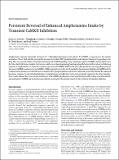Persistent Reversal of Enhanced Amphetamine Intake by Transient CaMKII Inhibition
Author(s)
Loweth, Jessica A.; Li, Dongdong; Cortright, James J.; Wilke, Georgia; Jeyifous, Okunola; Neve, Rachael L.; Bayer, K. Ulrich; Vezina, Paul; ... Show more Show less
DownloadLoweth-2013-Persistent Reversal.pdf (962.9Kb)
PUBLISHER_POLICY
Publisher Policy
Article is made available in accordance with the publisher's policy and may be subject to US copyright law. Please refer to the publisher's site for terms of use.
Terms of use
Metadata
Show full item recordAbstract
Amphetamine exposure transiently increases Ca2+/calmodulin-dependent protein kinase II (CaMKII) α expression in the nucleus accumbens (NAcc) shell and this persistently increases local GluA1 S831 phosphorylation and enhances behavioral responding to the drug. Here we assessed whether transiently interfering with CaMKII signaling using a dominant-negative CaMKIIα mutant delivered to the NAcc shell with herpes simplex viral vectors could reverse these long-lasting biochemical and behavioral effects observed following exposure to amphetamine. As expected, transient expression of CaMKIIα K42M in the NAcc shell produced a corresponding transient increase in CaMKIIα and decrease in pCaMKIIα (T286) protein levels in this site. Remarkably, this transient inhibition of CaMKII activity produced a long-lasting reversal of the increased GluA1 S831 phosphorylation levels in NAcc shell and persistently blocked the enhanced locomotor response to and self-administration of amphetamine normally observed in rats previously exposed to the drug. Together, these results indicate that even transient interference with CaMKII signaling may confer long-lasting benefits in drug-sensitized individuals and point to CaMKII and its downstream pathways as attractive therapeutic targets for the treatment of stimulant addiction.
Date issued
2013-01Department
Massachusetts Institute of Technology. Department of Brain and Cognitive SciencesJournal
Journal of Neuroscience
Publisher
Society for Neuroscience
Citation
Loweth, J. A., D. Li, J. J. Cortright, G. Wilke, O. Jeyifous, R. L. Neve, K. U. Bayer, and P. Vezina. “Persistent Reversal of Enhanced Amphetamine Intake by Transient CaMKII Inhibition.” Journal of Neuroscience 33, no. 4 (January 23, 2013): 1411-1416.
Version: Final published version
ISSN
0270-6474
1529-2401